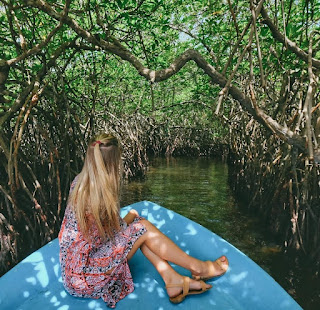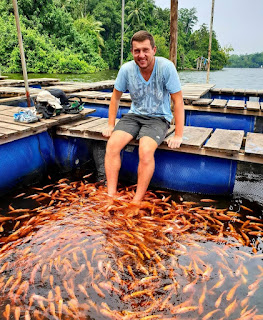The main road A2 crosses the Madu Ganga river mouth halfway between the two well-known coastal towns of Bentota and Hikkaduwa. This Madu River creates a complex network of mangrove swamps further upstream, as well as a large open lake dotted with islets. There are actually fewer islets in Madu Ganga Lake than the "32 islands" or "64 islands" labels suggest. The lagoon is another name for the lake. However, because it is a river lagoon, the water is not as salty as seawater lagoons that open to the ocean and is just mildly brackish. The Madu Ganga still qualifies as a freshwater lake.
Only Kalutara and Bentota, on Sri Lanka's southwest coast, are there actual seawater lagoons. The other so-called lagoons are all connected to the ocean via running tiny rivers rather than large gaps. Between Colombo and Galle, there is essentially a network of these somewhat salinized river lagoons, including Bolgoda Lake in Moratuwa, Owinka Lake, Dedduwa Lake, Madu Ganga, Madampe Lake, Hikaduwa Ganga, and Ratgama Lake, with Madu Ganga being by far the biggest.
The largest remaining mangrove swamp in Sri Lanka and an amphibious environment, Maduganga is home to several fish and reptile species. It's a great place to go bird watching as well. Together with the smaller Randombe Lake, which is located farther south but closer to the coast, and connected to the Madu River by two natural channels, it creates the Madu Ganga Wetland, which is home to almost 250 species of vertebrate animals and more than 300 species of plants. The International Ramsar Convention on Wetlands, a global agreement for the conservation and sustainable use of wetlands, classified Madu Ganga due to its rich biodiversity. The Iranian city of Ramsar, where the Convention on Wetlands was signed in 1971, bears its name.
Examine the Madu River.
Facts about the ecology of mangroves
🌟Mangrove trees dominate the entire area of the Madu River, which is surrounded by swampy marshlands.
🌟Over 150 acres, or 61 hectares, are covered by the forest. In this region, 14 of the 24 species of the mangroves can be found.
🌟Interesting to observe is how important a role mangroves play in avoiding erosion.
🌟During the disastrous tsunami in December 2004, when the forest served as a natural barrier defending the area, the worth of the mangroves was realized.
🌟A series of ecological benefits have resulted from the enormous mangrove tree growths. The mangrove trees provide protection for extremely fertile soil. The other wetland plants have grown a abundantly as a result of this.
🌟19 indigenous species out of nearly 300 have been found thus far.
🌟Due to the abundance of undiscovered species in the unattainable depths of the mangrove forests, the area continues to be a treasure trove for biologists and ecologists.
🌟In turn, the plant life has sustained a sizable number of wildlife species that rely on them.
🌟The wild boar is the largest mammal in the area. Other smaller creatures include monkeys, different species of squirrels, etc.
🌟When it comes to birds, kingfishers and cormorants are frequent visitors. The mangrove woodlands are a paradise for ardent bird watchers. The area is home to around 111 different species of birds.
🌟There are 31 different kinds of reptiles, including crocodiles, lizards, and snakes.
🌟The Madu River region is also home to approximately 50 different species of butterflies and 25 different types of mollusks.
MADU GANGA - BOAT TOURS
The Madu Ganga river bed, the constrained channel that connects the lake with the ocean, will be followed in the first segment of the boat excursion upstream. The largest mangove swamp in the entire wetland area is located between Madu Ganga Lake, Randombe Lake, and the ocean, yet it is not the only one. The beautiful green setting is reminiscent of a picture book with a tropical river.
Not only do foreign tourists visit Madu Ganga, but also many locals, especially on the weekends. Along the river's banks are a number of upscale hotels and guesthouses. Some of them provide wedding venues and ballrooms.Those Sri Lankans who can afford it choose to have their wedding celebrations in luxurious settings. The MADU GANGA - BOAT TOURS FOR LOCAL AND FOREIGN HOLIDAY CREATORS EQUALLY is where they can have a "fairy tale" wedding.
The first section of the boat trip will be upstream, following the Madu Ganga river bed, the restricted waterway that connects the lake with the ocean. Between Madu Ganga Lake, Randombe Lake, and the coast lies the largest mangove swamp in the entire wetland area, but it is not the only one. The lush, lovely landscape has a picture-book feel to it, complete with a tropical river.
Not only do foreign tourists visit Madu Ganga, but also many locals, especially on the weekends. Along the river's banks are a number of upscale hotels and guesthouses. Some of them provide wedding venues and ballrooms. Those Sri Lankans who can afford it choose to have their wedding celebrations in luxurious settings. The hotel will arrange a "fairy tale" wedding for them to take place in the middle of the Madu River. On certain occasions, some riverboats are even decorated with fresh flowers.
FISH MASSAGE SPAS
You can get a free natural fish massage by taking a Madu Ganga boat excursion. Within the Madu Ganga Wetland area, there are currently multiple fish spas. However, a local fish farm owner recently launched fish spa therapy after visiting facilities of a similar nature in Thailand. Additionally, it is particularly well-liked in Vietnam and Cambodia.
A natural foot massage using hundreds of fish is called fish spa therapy. You merely have to dip your feet into the ocean while perched on a pier. The calloused epidermis of your feet will soon be eaten away by fish, leaving only the dead scarf-skin. A nominal fee is charged to visitors who arrive by boat for this experience.For at least ten minutes, you should keep your feet in the fish spa.
There are numerous varieties of doctor fish to pick from. In fish spas, two fish species are typically employed. Garra Rufa, an authentic doctor fish, hails from the Middle East. Because they feed on psoriasis sufferers' skin and reduce the symptoms of this chronic illness, they have been used into medical therapies. Mozambique tilapia is an additional species utilized in fish spa therapies. The latter are different because they have teeth. Treatment for tilapia isn't painful, though.The fish at Madu Ganga fish spas are kept in their natural habitat, which makes them special.
Instead of closed bassins like in Thailand, constructed cage ponds in the river are where the fish massage is performed.The benefits of fish spa therapy are debatable. Fish spa therapy is not permitted in some US jurisdictions since it is thought to be unhygienic. The rationale is that medical implements must be sterilized or otherwise disposed of after use in accordance with cosmetology laws. However, several Western nations, like Canada and the United Kingdom, are open to the use of fish spa therapy.
Visits to Cinnamon Island
The Madu Ganga river's Cinnamon Island is widely known for its cinnamon production. Because cinnamon is made there using cinnamon trees that are planted there. Additionally, they also make cinnamon oil.
Visitors to Cinnamon Island in Madu Ganga are greeted with delectable cinnamon tea. A person also demonstrates to you how to prepare cinnamon and cinnamon oil. You are welcome to purchase their goods as well.
Largest inhabited island and longest bridge in Sri Lanka


.jpeg)



.jpeg)
